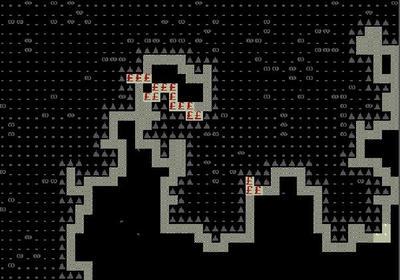- v50 information can now be added to pages in the main namespace. v0.47 information can still be found in the DF2014 namespace. See here for more details on the new versioning policy.
- Use this page to report any issues related to the migration.
40d:Vein
Veins and Clusters

Veins and clusters, fully revealed. Note this unusual copper (brown) vein has been folded over and reconnects with itself, and also overlaps one of the two hematite (red) veins. Also note the brown gems in the very top of the center hematite vein, and the various small clusters of gems across the level. The bottom quarter of a large cluster (of non-valuable stone) is at top right, with a small cluster of native aluminum (white chevrons) below it. This area is well above average - some areas this size have nothing to offer but callouses and disappointment.
(This view uses a 3rd party utility, and is not easily achieved in an unmodified game. See smaller image, below, of this same map with a more typical view.

The same map as above, except with tiles visible from the same exploratory mining shafts and tunnels only. This is what is more typically seen in gameplay, only the tiles visible from the exploratory mining itself. A lot of work and surprises ahead!
If a stone is not a layer stone, then it is found within a layer or another stone as a vein or a cluster. Veins and clusters do not jump z-levels, except by coincidence - a vein or cluster is limited to one z-level, but that doesn't mean the same stone can't be found above or below as well if the conditions (the surrounding stone) are right.
Non-layer stone formations occur in these patterns:
- Large cluster - An oval that occupies nearly half of a 48x48 block, area-wise, and centered in that block. These huge ovals consistently measure near 20 x 40 tiles, and average perhaps 750 stones each. Only one appears per block, and while veins and small clusters can be found in them, large clusters are usually not a valuable stone (magnetite being the one notable exception).
- Vein - A sinuous line of the material crosses part of the block. These vary from 1-4 tiles wide within a single vein and average about 100 stones each, but veins with over 200 stones have been reported*. When a vein ends, it does not start again unless it was broken by another vein, cluster or erosion (see below).
- (* It's ~possible~ that these are 2 identical veins lined up end-to-end, but it's unclear if there is an upper limit as to how big a single vein can be.)
- Small cluster - A sprinkle of 1 to 9 adjacent tiles. Multiple small clusters of different materials may be in the same block. These average 4-5 adjacent stones each and do not span more than three tiles in each direction. (That is, all tiles are enclosed in a 3x3 square area.)
- Single Gem - Rare gems show up only as a single example within a small cluster of similar precious gems.
With a few exceptions, if a block has a large cluster it will not have other veins or small clusters. Exceptions include raw adamantine veins, which can occur in any layer or large cluster in their block; olivine and chromite veins, which can contain demantoids; and magnetite and platinum veins. (...and possibly others?)
Rarely, two separate veins (of the same or different stone/ore) can be found "doubled", two next to each other, or (also rarely) folded back on themselves. Unrelated veins and clusters can intersect or overlap with each other - only one type of stone/ore/gem will be found in any one tile, however.
Note that erosion (during world-gen, pre-embark), magma (pools and pipes), water (brooks, rivers and pools), pits and chasms may reduce exposed veins and clusters to a fraction of their original starting size, and/or cut through them, exposing only the remnants, or two parts of a single vein in two nearby areas on the same z-level.
It is common to find certain gemstones embedded only in certain veins or large clusters. For instance, to find rubies and sapphires, explore bauxite clusters; for diamonds, one should follow any kimberlite veins they find, which in turn are found only in gabbro layers. Knowing what stone (or ore) contains what veins and clusters can be useful in exploratory mining and to understand the information given to you before you embark on a new game, and complete information for each can be found on the wiki page for that stone/ore/gem.
Raw adamantine is neither a typical stone nor metal ore, and veins of raw adamantine do not follow any of the normal patterns. They tend to be narrower, more spidery, and in fact are the only veins to (predictably) connect across z-levels, up and down within that 48x48 area block.
See also
- Stone
- Ore
- Gem
- Soil
- Exploratory mining
- (also, any individual types of stone, ore, or gem, by specific name - for instance, granite or gold.)
- And, for newer players, The Non-Dwarf's Guide to Rock
